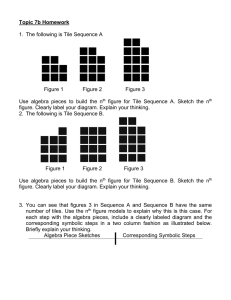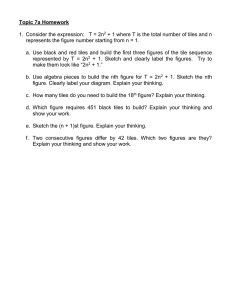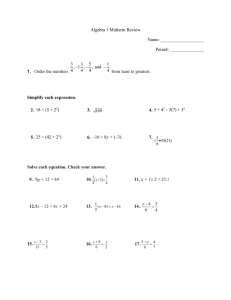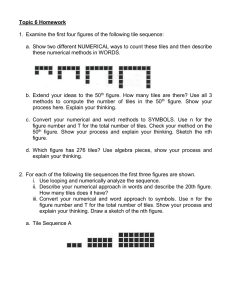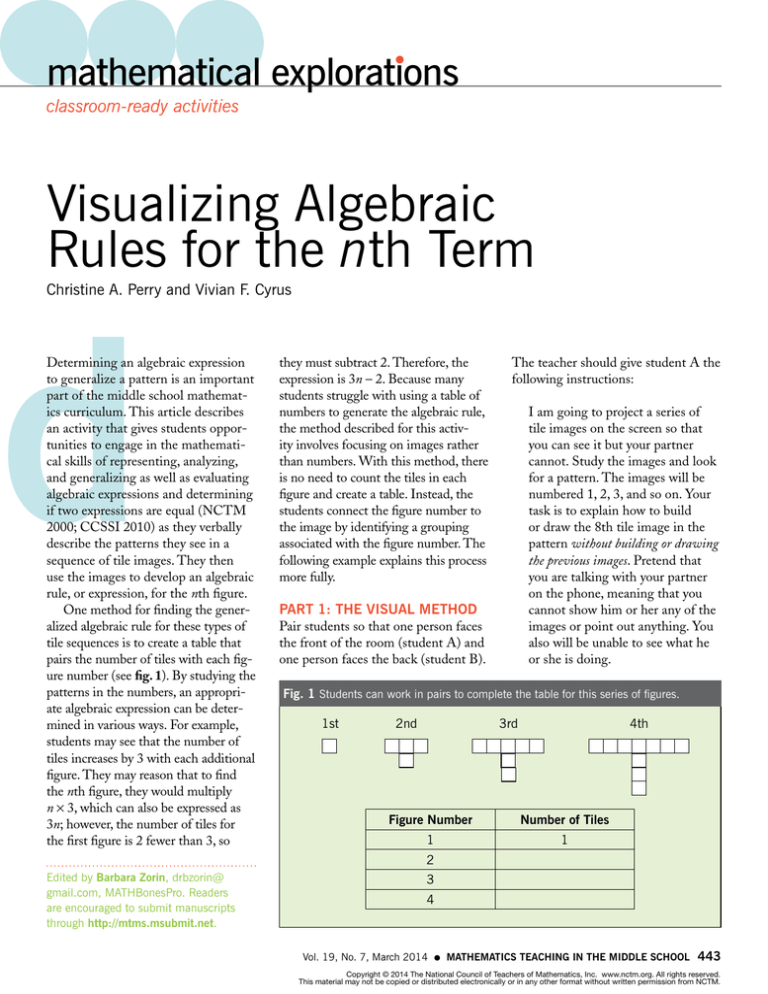
mathematical explorations
classroom-ready activities
Visualizing Algebraic
Rules for the nth Term
d
Christine A. Perry and Vivian F. Cyrus
Determining an algebraic expression
to generalize a pattern is an important
part of the middle school mathematics curriculum. This article describes
an activity that gives students opportunities to engage in the mathematical skills of representing, analyzing,
and generalizing as well as evaluating
algebraic expressions and determining
if two expressions are equal (NCTM
2000; CCSSI 2010) as they verbally
describe the patterns they see in a
sequence of tile images. They then
use the images to develop an algebraic
rule, or expression, for the nth figure.
One method for finding the generalized algebraic rule for these types of
tile sequences is to create a table that
pairs the number of tiles with each figure number (see fig. 1). By studying the
patterns in the numbers, an appropriate algebraic expression can be determined in various ways. For example,
students may see that the number of
tiles increases by 3 with each additional
figure. They may reason that to find
the nth figure, they would multiply
n × 3, which can also be expressed as
3n; however, the number of tiles for
the first figure is 2 fewer than 3, so
they must subtract 2. Therefore, the
expression is 3n – 2. Because many
students struggle with using a table of
numbers to generate the algebraic rule,
the method described for this activity involves focusing on images rather
than numbers. With this method, there
is no need to count the tiles in each
figure and create a table. Instead, the
students connect the figure number to
the image by identifying a grouping
associated with the figure number. The
following example explains this process
more fully.
Part 1: the Visual Method
Pair students so that one person faces
the front of the room (student A) and
one person faces the back (student B).
The teacher should give student A the
following instructions:
I am going to project a series of
tile images on the screen so that
you can see it but your partner
cannot. Study the images and look
for a pattern. The images will be
numbered 1, 2, 3, and so on. Your
task is to explain how to build
or draw the 8th tile image in the
pattern without building or drawing
the previous images. Pretend that
you are talking with your partner
on the phone, meaning that you
cannot show him or her any of the
images or point out anything. You
also will be unable to see what he
or she is doing.
Fig. 1 Students can work in pairs to complete the table for this series of figures.
1st
2nd
3rd
4th
Figure Number
Number of Tiles
1
1
2
Edited by Barbara Zorin, drbzorin@
gmail.com, MATHBonesPro. Readers
are encouraged to submit manuscripts
through http://mtms.msubmit.net.
3
4
Vol. 19, No. 7, March 2014
●
Mathematics Teaching in the Middle School
443
Copyright © 2014 The National Council of Teachers of Mathematics, Inc. www.nctm.org. All rights reserved.
This material may not be copied or distributed electronically or in any other format without written permission from NCTM.
The teacher gives student B the following instructions:
ou will be facing away from
Y
the screen so you cannot see the
images. Listen carefully to your
partner and build or draw the 8th
image in the pattern as it is being
described. Remember to imagine
that you are talking on the phone,
so you cannot look at anything that
your partner writes, and he or she
cannot see what you are doing.
Once the students understand their
roles in the activity, project the pattern
shown on activity sheet 1, so that it is
only visible to student A.
The goal of this activity is for
students to identify an explicit, rather
than a recursive, pattern. A recursive pattern requires that one knows
the previous term; however, with an
explicit pattern, the algebraic rule for
the nth term can be determined independently of the preceding figure.
As students are completing this
activity, circulate around the room to
watch for signs of recursive thinking. If student A is asking student
B to build or draw the 8th image by
first building or drawing the previous 7 images, then he or she is using
a recursive pattern and not an explicit
pattern, as intended. This type of
thinking will not lead to the explicit
rule. Guide students to incorporate
the image number in some way.
Sometimes it helps to ask how they
would explain how to draw the 50th
image (because we certainly do not
want them to do that recursively).
that students understand that 7 represents the number of tiles it takes to
build the 3rd image.
With different perspectives, students will get different expressions for
the same pattern. What follows is a
sample of the various approaches that
some students have taken to describe
the 8th image and how that description can be used to generate an algebraic expression for the nth term.
Part 2: The Visual Method
This activity usually reveals more
than one way of seeing an explicit
pattern in these figures. To promote
discussion and note taking of the different approaches, give each student
a copy of activity sheet 1. Assure the
class that the pattern can be seen in
various ways. Encourage students to
share how they described the pattern
to their partner or how it was described to them. As students explain
their thinking, use the images on
activity sheet 1 to illustrate how they
can be shaded.
Next, show students how to sketch
the 8th image and use that sketch to
determine the number of tiles. Repeat
this process with the 50th image.
Finally, demonstrate how to generalize a sketch of the nth image and how
to write an algebraic expression to
represent the number of tiles in the
nth image. Point out that this expression can be used to determine the
number of tiles in each image. For
example, if you substitute 3 into their
expression for pattern 1 and evaluate
it, you should get 7. It is important
Description 1: The overall shape
is like a T. Put 8 tiles vertically down
the center, then put 7 tiles horizontally
on each side of the top tile. With this
description, students are seeing the
pattern shown in figure 2. The vertical
column of tiles down the center is the
same as the figure number. To illustrate, we shade that vertical column of
tiles. The number of tiles on each side
of the top tile is one fewer than the
term number. If we use n to represent
the figure number, then we have
n tiles down the center with n – 1 tiles
on each side. To generate the algebraic
expression that represents the number
of tiles in the nth figure, we simply
add these parts together, or find
n + (n – 1) + (n – 1).
Description 2: You are going to make
a T. Put 1 tile down, which is the center
tile. Then put 7 tiles in a row to the
right of the center tile, 7 tiles in a row
Fig. 2 For the 8th image, this configuration is described, “Put 8 tiles vertically down the center, then put 7 tiles horizontally on
each side of the top tile.”
1st
2nd
3rd
4th
...
8th
8 –1
7
. . .
8 –1
7
8
50th
50 –1 50 –1
49
49
2(50 - 1) + 50
2(49) + 50
98 + 50
148
1
444
Mathematics Teaching in the Middle School
●
7
nth
n –1
2(n - 1) + n
1
7
n –1
n
50
2(8 - 1) + 8
2(7) + 8
14 + 8
22
7
Vol. 19, No. 7, March 2014
. . .
49
49
1
49
n –1
n –1
n –1
8 –1
7
8 –1
7
50 –1 50 –1
49
49
8
n –1
n –1
n
50
Fig. 3 For the 8th image, this configuration is described, “Put one tile down. This is the center tile. Then put 7 tiles in a row to the
–1 center
8 –1 tile.” 50 –1 50 –1
right of the center tile, 7 tiles in a row to the left, and 7 tiles below8 the
7
1st
2nd
3rd
4th
7
49
. 8. . n –1
49
8th 50 . . . 50th
1
7
7
n. . . nth
1
7
49
7
1
7
7
n –1
1
n –1
49
n –1
n –1
49
3(7) + 1 1
3(49) + 1 1
3(n – 1) + 1
21 + 49
1
147
+
1
n –1
n –1
49
22
148
n –1
49
2(50) –1=99
2(8) –1=15
2n –1
Fig. 4 For the 8th image, this configuration is described, “Put 15 tiles in a row horizontally. Then put 7 tiles vertically beneath the
1st
2nd
50 –1=49
8 –1=7
center tile.”
3rd
4th
...
to the left, and 7 tiles below the center
tile. The focus here is on the one tile
in the center (see fig. 3). Each of the
three branches off this center tile has
one fewer tile than the figure number.
If the figure number is n, then the
number of tiles in each branch is n – 1.
There are 3 branches, so we have
3(n – 1). Adding the center tile yields
the expression 3(n – 1) + 1. Some students who see the pattern this way will
write (n – 1) + (n – 1) + (n – 1) + 1.
Description 3: Put 15 tiles in a row
horizontally. Then put 7 tiles vertically beneath the center tile. A student observed
that the number of tiles in the top part
of the T can be found by doubling the
figure number and then subtracting 1,
which can be expressed as 2n – 1. The
number of tiles below the center tile is
n – 1. The total number of tiles is the
8th
...
50th
...
n –1
nth
2(8) –1=15
2(50) –1=99
2n –1
8 –1=7
50 –1=49
n –1
[2(8) – 1] + (8 – 1) [2(50) – 1] + (50 – 1) (2n – 1) + (n – 1)
[16 – 1] + 7
[100 – 1] + 49
15 + 7
99 + 49
22
148
sum of these two expressions, or
(2n – 1) + (n – 1) (see fig. 4).
Developing rules with this method
often results in different, but equivalent, algebraic expressions. These
rules provide an ideal opportunity to
reinforce students’ developing skills
at simplifying expressions and using
them to determine if two expressions
are equivalent. As students present
different expressions for the same pattern, ask them how they can tell if the
pattern is equivalent to the expression
already presented. Some students may
determine equivalence by substituting
a value for n and then evaluating the
numerical expression. These students
may need guidance to appreciate that
their algebraic skills for simplifying
expressions can also be used to determine equivalence. For example, each
Vol. 19, No. 7, March 2014
●
of the expressions developed from
the three descriptions above can be
simplified to 3n – 2.
Extending to Quadratic
Expressions
In the Common Core State Standards for Mathematics (CCSSM),
the focus at the middle school level
is on linear functions and equations
(CCSSI 2010). However, we include
examples of patterns that lead to quadratic expressions because the intent
of this activity is to give students the
opportunity to write algebraic expressions and determine if two expressions are equivalent. It is unnecessary
for students to be able to recognize
or manipulate quadratic expressions
to be successful in writing them.
Equivalence between two quadratic
expressions can be determined by
Mathematics Teaching in the Middle School
445
substituting values for the variable,
thus providing practice in evaluating
expressions.
The rule for the nth term in the example discussed previously resulted in
a linear expression because the first dif-
ferences in the number of tiles between
consecutive terms were constant. If the
first differences are not constant, but
the second differences are constant (see
fig. 5), then the rule for the nth term
will be a quadratic expression. We will
Fig. 5 The differences of the first row of numbers are listed in the second row. These
differences are not constant. However, the second differences are constant, which is a
characteristic of a quadratic sequence.
2
1st differences
5
10
17
26
37 …
35 7911
2nd differences 2222
Fig. 6 Even without a knowledge of quadratic equations, students can determine
quadratic sequences with visual models.
1st
2nd
3rd
4th
...
50th
...
n
50
50 502=2500
1 = 1 2 = 4
2
2
3 = 9
2
4 = 16
2
nth
502=50
50 = 2500
2
n
n2
n2
n2
(a)
1st
2nd
3rd
4th
. . . nth
(b)
refer to these as quadratic sequences.
Many quadratic sequences can be
modeled visually using images of tile
patterns; the rule for the nth term can
be determined using these images. A
simple example is shown in figure 6a.
In this example, the term number is
the length of the square; therefore, the
number of tiles in the nth term can be
found using the expression n2.
Consider the tile pattern shown in
figure 6b. There are several ways the
rule for this sequence could be determined through visual inspection. One
observation is that the term number
corresponds to the height of the first
column in each tile image, thus leading to the discovery of an n × n square
imbedded in the image. If we set aside
that square and look at the remaining
image, we find an n × (n – 1) rectangle.
For the first term, this would be a
1 × 0 rectangle, so it is not pictured.
Finally, each image has two additional
tiles. This description is depicted in
figure 7. The expression for the total
number of tiles in the nth term is the
sum of the areas of the rectangles,
n2 + n(n – 1) + 2, which can be simplified to 2n2 – n + 2.
After a rich classroom discussion
on developing algebraic rules from
patterns and determining if expressions
resulting from the different perspectives are equivalent, students should
be equipped to successfully complete
activity sheet 2. This activity provides
practice in writing rules for patterns
that result in both linear and quadratic
expressions. Additional resources and
Fig. 7 This coloration demonstrates one way that the sequence in figure 6b can be dismantled and understood.
1st
2nd
3rd
4th
. . .
nth
n
n–1
n
446
Mathematics Teaching in the Middle School
●
Vol. 19, No. 7, March 2014
2
n
two of the Standards for Mathematical
Practice: Standard 3: Construct viable
arguments and critique the reasoning
of others and Standard 4: Model with
mathematics (CCSSI 2010).
examples for teaching this content can
be found in Navigating through Algebra
in Grades 6-8 (NCTM 2004).
DEVELOPING ALGEBRAIC
SKILLS
We believe that that this method of
generalizing a rule to find the nth
term of a sequence not only provides
an alternative method for finding the
expression but also gives students an
opportunity to use their developing
algebraic skills with purpose. Because
different forms of the expression will
emerge from the diverse ways that
they see the pattern, students must
simplify or evaluate these expressions
to determine if they are equivalent.
With this process of modeling and
then verifying that the expressions are
equivalent, students are engaging in
References
Common Core State Standards Initiative
(CCSSI). 2010. Common Core State
Standards for Mathematics. Washington, DC: National Governors Association Center for Best Practices and the
Council of Chief State School Officers.
http://www.corestandards.org/assets/
CCSSI_Math%20Standards.pdf
National Council of Teachers of Mathematics (NCTM). 2000. Principles
and Standards for School Mathematics
Reston, VA: NCTM.
———. 2004. Navigating through Algebra
in Grades 6-8 Reston, VA: NCTM.
Christine A. Perry,
c.perry@moreheadstate
.edu, is an associate professor at Morehead State
University in Morehead,
Kentucky, where she
teaches content courses
for future elementary
school and middle school
teachers as well as methods courses for
future secondary mathematics teachers.
She also enjoys presenting at conferences
and providing professional development
for in-service teachers in the region.
Vivian F. Cyrus, v.cyrus@moreheadstate
.edu, is an associate professor of mathematics at Morehead State University,
where she teaches mathematic content
courses. She enjoys working with students on undergraduate research as well
as presenting at conferences.
INSPIRING TEACHERS. ENGAGING STUDENTS. BUILDING THE FUTURE.
.OR
G
s
c
i
t
L
a
O
H
SC O
m
E
L
e
D
math MID
N AT
ION
AL
NC
COU
A
F TE
IL O
CHE
A
F M
RS O
MA
THE
TICS
W
• W
W. N
CTM
APRIL
42"
in the
hing
teac
Let NCTM Help You
Make Your Job Easier!
2013
13"
16"
We have the resources to meet your challenges.
Check out www.nctm.org/middle for:
18"
ing
Fram
¼ + = % < - > ÷ x (a+b) × ½ ± µ ¾ ¢ 90° y2 $ ¼ + = % < - >
(a+b) × ½ ± µ ¾ ¢ 90° y $ ¼ + = % < - > ÷ x3 (a+b) × ½
± µ ¾ ¢ 90° y2 $ ¼ + = % < - > ÷ x (a+b) × ½ ± µ p¾.47¢4 90° y2 $
¼ + = % < - > ÷ x (a+b) × ½ ± µ ¾ ¢ 90° y $ ¼ + = % < - >
(a+b) × ½ ± µ ¾ ¢ 90° y
(a+b) × ½
± µ ¾ ¢ 90° y2 $ ¼ + = % < - > ÷ x (a+b) × ½ ± µ ¾ ¢ 90° y $
84
S p.4
¼+=%<->÷x
$¼+=%<->
TION
92
FRAC
NING RITING p.4
EETE
W
W
3
S
N
O
(a+b) × ½ ± µ ¾••¢DRA90°
WING y $ ¼ + = % < - > ÷ x (a+b) × ½
Math
• Lessons and activities
•
•
•
•
¼ + = % < - > ÷ x3 (a+b) × ½ ± µ ¾ ¢ 90° y2 $ ¼ + = % < - > ÷ x3 (a+b) ×
½ ± µ ¾Problems
¢ 90° y2 $ ¼ +database
= % < - > ÷ x3 (a+b) × ½ ± µ ¾ ¢ 90° y2 $ ¼ + = %
3
< - > ÷ Core
x (a+b)math
× ½ ± µtools
¾ ¢ 90° y2 $ ¼ + = % < - > ÷ x3 (a+b) × ½ ± µ ¾
2
¢ 90° y $ ¼ + = % < - > ÷ x3 (a+b) × ½ ± µ ¾ ¢ 90° y2 $ ¼ + = % < - > ÷
Online
x3 (a+b) ×
½ ± µ ¾articles
¢ 90° y2 $ ¼ + = % < - > ÷ x3 (a+b) × ½ ± µ ¾ ¢ 90° y2
$ ¼ + =Topic
% < - >resources
÷ x3 (a+b) × ½ ± µ ¾ ¢ 90° y2 $ ¼ + = % < - > ÷ x3 (a+b)
× ½ ± µ ¾ ¢ 90° y2 $ ¼ + = % < - > ÷ x3 (a+b) × ½ ± µ ¾ ¢ 90° y2 $ ¼ + =
% < - > ÷ x3 (a+b) × ½ ± µ ¾ ¢ 90° y2 $ ¼ + = % < - > ÷ x3 (a+b) × ½ ± µ
¾ ¢ 90° y2 $ ¼ + = % < - > ÷ x3 (a+b) × ½ ± µ ¾ ¢ 90° y2 $ ¼ + = % < - >
÷ x3 (a+b) × ½ ± µ ¾ ¢ 90° y2 $ ¼ + = % < - > ÷ x3 (a+b) × ½ ± µ ¾ ¢ 90°
Vol. 19, No. 7, March 2014
●
Mathematics Teaching in the Middle School
447
activity sheet 1
Name ______________________________
EXAMINING A PATTERN
Follow the teacher’s instructions for how to shade the series of figures in each set.
Set 1
1st
2nd
3rd
4th
...
8th . . . nth
2nd
3rd
4th
...
8th . . . nth
2nd
3rd
4th
...
8th . . . nth
Set 2
1st
Set 3
1st
from the March 2014 issue of
activity sheet 2
Name ______________________________
DEVELOPING RULES FOR NUMBER PATTERNS THROUGH IMAGES
1.a. Study the images below. Shade them to represent how you see the pattern.
1st
2nd
3rd
4th
b. Describe how to build the 8th shape.
c. Sketch the 8th shape. How many squares does it contain?
d. Sketch the nth shape. Write an algebraic expression to represent the number of squares in the nth shape.
2.a. Study the images below. Shade them to represent how you see the pattern.
1st
2nd
3rd
4th
...
from the March 2014 issue of
8th
. . . nth
activity sheet 2
continued
Name ______________________________
b. Describe how to build the 8th shape.
c. Sketch the 8th shape. How many squares does it contain?
d. Sketch the nth shape. Write an algebraic expression to represent the number of squares in the nth shape.
3.a. Study the images below. Shade them to represent how you see the pattern.
1st
2nd
3rd
4th
b. Describe how to build the 8th shape.
c. Sketch the 8th shape. How many squares does it contain?
from the March 2014 issue of
. . . 8th
...
nth
activity sheet 2
continued
Name ______________________________
d. Sketch the nth shape. Write an algebraic expression to represent the number of squares it contains.
4.a. Study the images below. Shade them to represent how you see the pattern.
1st
2nd
3rd
4th
...
8th
b. Describe how to build the 8th shape.
c. Sketch the 8th shape. How many squares does it contain?
d. Sketch the nth shape. Write an algebraic expression to represent the number of squares it contains.
from the March 2014 issue of
. . . nth



